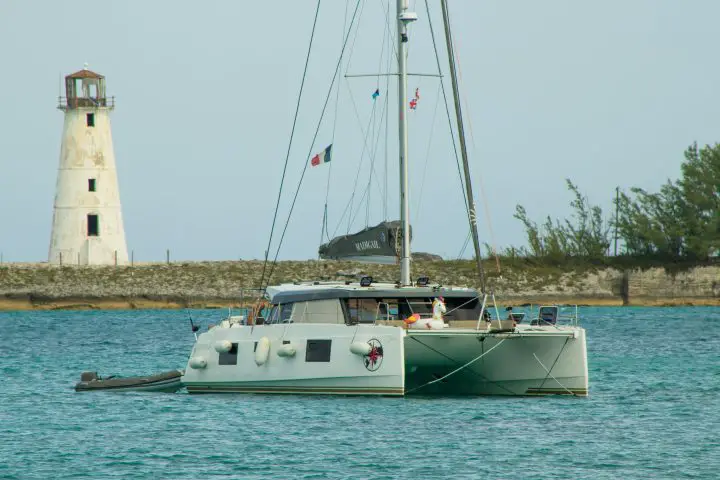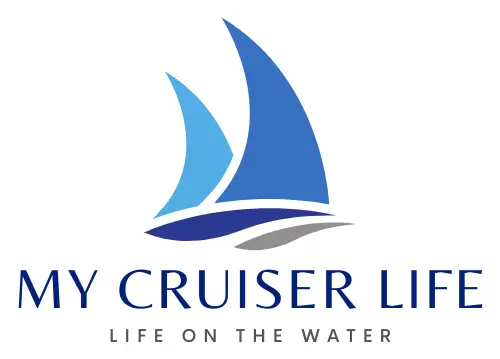Navigating catamaran hull characteristics requires expert knowledge. These underwater secrets can make or break your sailing experience. From how a hull slices through waves to its stability tricks, the right design means the difference between a smooth ride and a choppy nightmare. Pro sailors know that hull characteristics are the hidden magic behind an awesome boat – and now you can too.

Table of Contents
- Monohull vs. Catamaran Hulls
- Stability and Balance
- Speed and Efficiency
- Hull Materials
- Draft and Shallow Water Performance
- Load Carrying Capacity
- Seaworthiness and Safety
- Finding Your Perfect Hull
- FAQs – Catamaran Hull Characteristics
Monohull vs. Catamaran Hulls
Let’s break down the key differences between these two popular hull designs:
Monohull:
- A single hull that cuts through water like a knife through butter
- Heels (tips sideways) when sailing – scary for newbies, informative for veterans
- Limited speed based on waterline length, though modern designs can “plane”
- More traditional sailing experience with that classic rocking motion
- Narrower living spaces but cleverly designed
- Generally cheaper to build, maintain, and dock
- Easier to find marina space for
Catamaran:
- Twin hulls that skim over water like skis on snow
- Stays flat and stable – great for those prone to seasickness
- Faster in light to moderate winds thanks to reduced drag
- Spacious living areas both above and below deck – like a floating apartment
- More expensive to purchase and maintain
- Higher docking fees due to wider footprint
- Superior initial stability in most conditions
The choice comes down to your priorities – the authentic sailing feel of a mono or the space and stability of a cat. Both designs have their die-hard fans for good reason!
Stability and Balance
Ever notice how catamarans barely tip while monohulls heel over? It’s all about that wide beam between the twin hulls. This design creates an impressive metacentric height and righting moment – fancy terms that mean “really hard to flip over.”
Think of it like standing with your feet shoulder-width apart versus together. You’d need a serious shove to topple someone in a wide stance – that’s your catamaran right there!
This stability isn’t just about safety – it’s about comfort too. Cats drastically reduce the rolling motion that makes passengers reach for the dramamine. When a wave lifts one hull, the other might still be in a trough, balancing things out naturally.
The minimal heeling means gear and people aren’t sliding around the deck when things get choppy. Your coffee stays in the cup, not on your lap!
While cats excel in most conditions, they do move differently in severe weather – sometimes with quicker, more jarring motions than a monohull’s predictable roll. But for coastal cruising and island hopping, that stable platform is tough to beat.
Related: Through Hull Fittings Below the Waterline
Speed and Efficiency
Unlike monohulls that plow through waves, catamarans distribute weight across two slim hulls with less wetted surfaces. Think of trading a snow shovel for skis – you’re gliding instead of pushing.
This reduced water resistance is why cats can reach impressive speeds, especially in lighter winds. While monohulls hit a mathematical “hull speed” ceiling based on waterline length, catamarans can plane across the surface, easily maintaining 10-15 knots when conditions are right.
For cruisers, this efficiency translates directly to fuel savings. The hydrodynamics of catamaran hulls mean you’ll burn 30-40% less diesel at cruising speeds compared to similar-sized monohulls. That’s not just good for your wallet – it extends your range between islands and means less time running those noisy engines.
The best part? These performance advantages get better as cats get bigger, without the exponential increase in drag that larger monohulls suffer. No wonder so many cruisers are drawn to these fast, efficient sailing platforms when planning extended voyages.
Hull Materials
Most modern cats feature fiberglass and composite materials because they hit that sweet spot of strength, weight, and affordability. Builders layer fiberglass cloth with resins, and fancy resin infusion techniques create stronger bonds with fewer air bubbles than hand layup methods.
Aluminum has earned its fans among serious cruisers because it can take a serious knock and often just dents rather than cracks. It dissipates heat quickly in tropical waters but weighs more than fiberglass.
When speed is everything, carbon fiber enters the chat. This premium composite delivers extraordinary strength with minimal weight – perfect for racing cats and luxury builds. Your wallet will feel the difference too!
Don’t count out marine plywood and wooden constructions. Modern epoxy resins have given wooden boats new life, creating water-resistant barriers that dramatically extend their lifespans. Some builders even combine wood with fiberglass sheathing for the best of both worlds.
Related: Basics of Sailboat Hull Design
Draft and Shallow Water Performance
Catamarans shine in shallow waters where monohulls fear to tread. With typical drafts of just 2-4 feet (compared to 6+ feet on comparable monohulls), cats can slip into skinny water with confidence. It’s like wearing snowshoes versus boots in deep snow – wider distribution means less sinking!
Many cruising cats feature retractable daggerboards or centerboards that give you the best of both worlds. Drop them down for upwind performance, then pull them up when you want to nose right onto that perfect beach. Some owners even purposely “dry out” their cats at low tide for hull cleaning or quick inspections.
When threading through coral or navigating unmarked shallows, that reduced draft becomes your best insurance policy. The twin-hull design helps distribute impact if you do bump something, turning potential disasters into minor inconveniences.
That shallow-water capability transforms your anchoring options too. Cats can tuck in closer to shore, finding protection from wind and swell that deeper boats can’t reach. For adventurous cruisers, the ability to beach a catamaran (with proper tide calculations!) means instant beach access without even launching the dinghy.
Load Carrying Capacity
Catamarans excel in load-carrying capabilities due to their twin-hull design. The dual hulls significantly increase buoyancy compared to monohulls, creating approximately twice the displacement potential while maintaining performance characteristics.
Unlike monohulls that sink deeper when loaded, catamarans distribute weight across two hulls, maintaining their designed waterline regardless of cargo. This creates a more efficient load-to-length ratio and preserves sailing performance even at capacity.
The bridge deck structure offers ideal weight distribution. Cruisers can position heavy items like water tanks and batteries in both hulls at waterline level, keeping the center of gravity optimal. Proper weight distribution is crucial – asymmetrical loading can create handling imbalances.
The catamaran’s wide beam generates substantially more storage volume than comparable monohulls, improving both capacity and accessibility to stored items. For long-distance cruisers, this expanded cargo space enables extended provisioning, with many catamaran owners storing supplies for months without compromising sailing characteristics or comfort.
Seaworthiness and Safety
When the weather turns nasty, catamarans handle things differently than their monohull cousins. Those twin hulls slice through waves instead of climbing over them – it’s like having two knives cutting through water rather than one blunt object.
That famous “wave piercing” ability can transform a potentially rough ride into something manageable, though you’ll feel quicker, sometimes jerkier movements compared to a mono’s predictable roll. Having taken cats through some sporty conditions, I’ve found the key is understanding how your particular boat handles different wave angles.
Modern cruising catamarans come loaded with safety features:
- Watertight bulkheads create multiple sealed compartments
- Strategic floatation chambers provide reserve buoyancy
- Deep-V sections at the bow to deflect water and reduce slamming
- Carefully engineered bridge deck clearance to minimize “slams” in rough seas
What about that “cats don’t self-right” concern? While it’s true that once flipped, most cruising cats stay that way, catastrophic capsizes are exceptionally rare when sailed conservatively. The stats tell the story – respect your weather windows, reef early, and your cat will reward you with remarkable seaworthiness in challenging conditions.
Finding Your Perfect Hull
Choosing between a monohull and a catamaran ultimately comes down to your sailing priorities. Monohulls deliver that authentic sailing experience with a more wallet-friendly price tag. Cats offer incredible stability, impressive speed, and spacious living areas that feel like home. With their shallow draft, catamarans can explore hidden coves and beaches that monohulls simply can’t reach. The perfect boat isn’t about following trends – it’s about matching your vessel to your adventures. Now you’re equipped to choose the hull that will turn your sailing dreams into reality!
FAQs – Catamaran Hull Characteristics
What are the advantages of a catamaran hull?
Catamaran hulls offer superior stability, reduced rolling, and increased deck space. They provide excellent fuel efficiency, higher speeds, and shallow draft capabilities. With twin hulls, catamarans deliver smoother sailing, less water resistance, and improved comfort compared to traditional monohull vessels, making them ideal for both leisure and performance sailing.
What are the disadvantages of a catamaran hull?
Catamaran hulls can be more expensive to purchase and maintain. They have higher initial costs, wider beams requiring special marina considerations, and potentially more complex rigging. Some sailors find them less maneuverable in tight spaces, and they can be more susceptible to wind effects due to their broader profile.
Can catamarans handle rough seas?
Catamarans generally handle rough seas well, with their twin hulls providing excellent stability and reduced pitching. Their design minimizes wave impact and offers a smoother ride compared to monohulls. However, extreme conditions can still challenge even well-designed catamarans, and sailor skill remains crucial in navigating challenging maritime environments.
